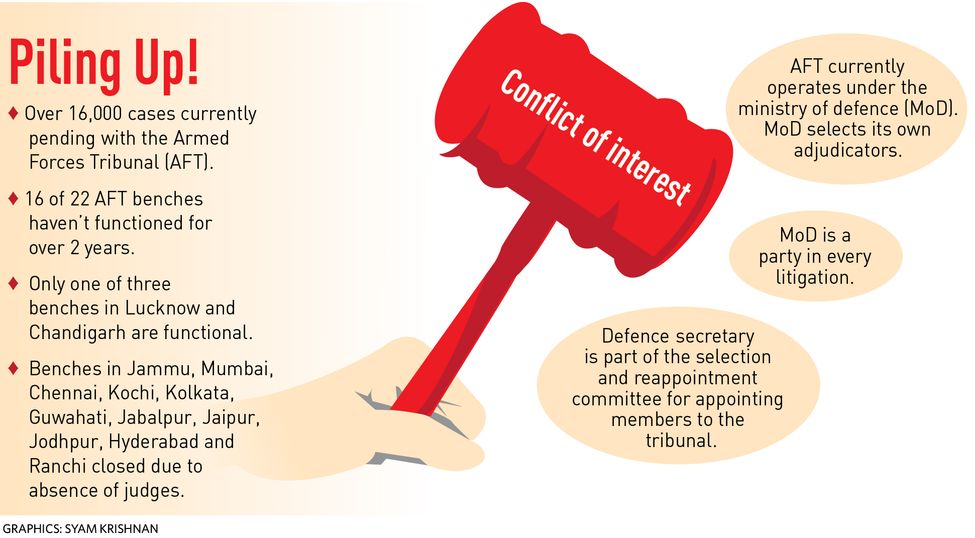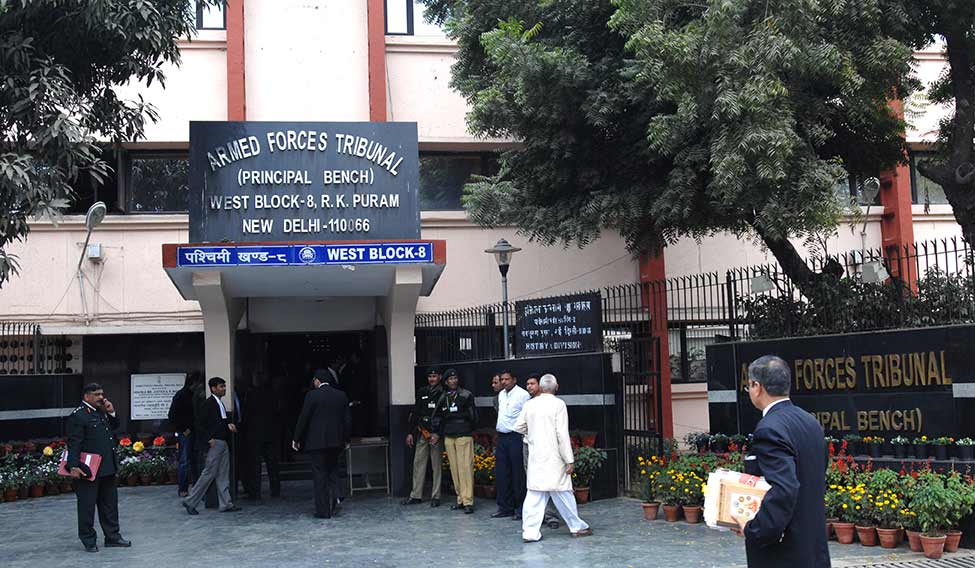I strongly believe, a soldier should be on border rather than standing in court for justice,” said defence minister Manohar Parrikar in July 2015, when he constituted a committee of experts to suggest ways to reduce litigation related to the armed forces. Four months later, the committee submitted a 509-page report, recommending 75 remedial measures that would help lower the burden on the military justice system.
Nearly two years later, the ground situation has not changed. Lt Col Mahesh Malhotra, an infantry officer posted in the Tangdhar sector near the Line of Control, has been coming to Delhi almost every month for the proceedings of a case related to his promotion. Each time, he gets the next date for appearance. The case has been dragging on for more than four years.
Col M. Singhal, an Ordnance Corps officer, moved the Delhi bench of the Armed Forces Tribunal (AFT) against a disciplinary order in 2013. Unable to get a date for hearing, he took his case to the Kolkata bench, and then to the Lucknow bench. He is now posted under the Central Command, and has spent most of his savings on lawyer fees and travel expenses.
Malhotra and Singhal’s troubles point to the deep malaise in the system. Sixteen of 22 benches of AFT, established in 2009 to provide speedy justice to aggrieved soldiers and retired defence personnel, have not been functioning for the past two years. As many as 16,000 cases are pending in various benches, according to the tribunal’s own data. In the absence of judges, the benches in Mumbai, Chennai, Kolkata, Kochi, Guwahati, Jabalpur, Jaipur, Jodhpur, Jammu, Hyderabad and Ranchi are closed. In Delhi, only two of three benches are functioning, while Lucknow and Chandigarh have only one of three benches working.
“The whole purpose of setting up AFT is defeated if defence personnel do not get justice,” Lt Gen (retd) K.P. Dhal Samantha, one of the founding members of the tribunal, told THE WEEK. According to him, AFT’s initial years were impressive, but judges gradually lost interest in serving at the tribunal.
Experts have pointed out the conflict of interests in AFT functioning under the defence ministry. In 2012, the Punjab and Haryana High Court admitted a petition contending that AFT should be under the Union law ministry. “It is a paradox, where the opposite party becomes the controlling authority. Unless you take control out of the MoD (ministry of defence), one cannot expect impartial and timely justice from AFT,” said Major (retd) Navdeep Singh, who has moved the Supreme Court challenging the defence ministry’s authority over AFT.

In his petition, Major Navdeep pointed out that the defence ministry is party to every case that comes before AFT. Also, the defence secretary is part of the committee that selects and appoints members of the tribunal, which means the primary litigant is able to select the adjudicators.
The 2007 Armed Forces Tribunal Act (AFTA) does not give AFT civil contempt powers, which are enjoyed by the Central Administrative Tribunal and the Securities Appellate Tribunal. In its report, the committee of experts set up by the defence ministry in 2015 noted, “It is a matter of grave concern that, out of the total litigation related to the defence services pending before various courts and tribunals, a major chunk is applications or petitions for execution of judgments [passed by AFT].”
Also, the tribunal is the first and final court for most litigants, as there is little scope for filing appeals in the Supreme Court, except on matters of “general public importance”. There is, effectively, no provision that enables litigants to question any delay in implementing AFT’s orders. This provides a kind of immunity to the respondents, who are mostly government agencies.
“The government does not want to lose control of AFT because majority of tribunal judgments make MoD uncomfortable,” said Samantha. That is why, he said, Parliament has not passed an amendment to AFTA despite it being cleared by the Union cabinet.
“It is a demotivating factor, as majority of [AFT’s] orders are ignored by the MoD. Orders keep pending for long with the ministry,” said Maj Gen (retd) Nilender Kumar. As head of the JAG (judge advocate general) branch of the Army for more than seven years, Kumar had worked with three defence ministers and four Army chiefs, and had played a key role in setting up the tribunal.
A few years ago, the “lack of teeth” in AFTA prompted the Kerala High Court to rule that AFTs could use criminal contempt powers under the “inherent powers and provisions” within the act itself. Challenging this decision in the Supreme Court, the government gave an undertaking that it would amend the act so as to provide AFT with civil contempt powers.
“Conditions of the Armed Forces Tribunal are shocking and deplorable,” said Nilender Kumar. “Judicial members do not come, because they do not find the tribunal jobs adequate and attractive. No serving judge will come leaving his or her constitutional job, [as AFT offers] no additional perks and benefits.”
Each AFT bench has two members—one judicial and one administrative. While the judicial member has to be a retired or serving High Court judge, the administrative member is chosen from the three services. Officials say efforts are on to include civil servants as administrative members.
To resolve the issue of shortage of staff, the amendment to AFTA has proposed to extend the tenure of chairperson and members from four to five years, and the age limit for judicial members, in case they have been High Court chief justices, from 65 to 67 years.
“This would avert repeated selection of members for short tenures, and provide the tribunal with stability and continuity,” said Samantha. “If we are able to give longer terms to judicial members, and postings closer to their hometowns, it will attract them to join AFT.”
The immediate concern, however, is reducing the number of pending cases. Navdeep said that before AFT was established, the pendency was 9,000 cases. But within a couple of years of AFT coming into being, he said, the figure went up to 15,000. The real reason behind establishing AFT, according to Navdeep, was “not to reduce pendency, but to create post-retirement havens and to tacitly and slowly encroach upon the traditional jurisdiction of real courts, including on matters of personal, individual and civil rights”.
Some names have been changed to protect identity.







